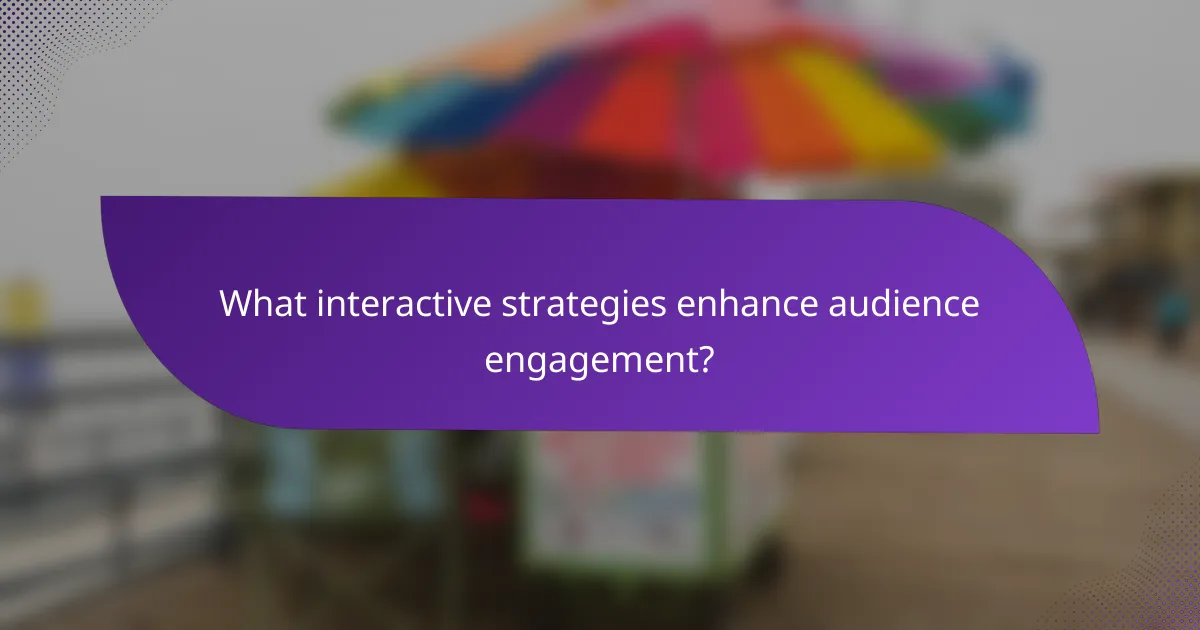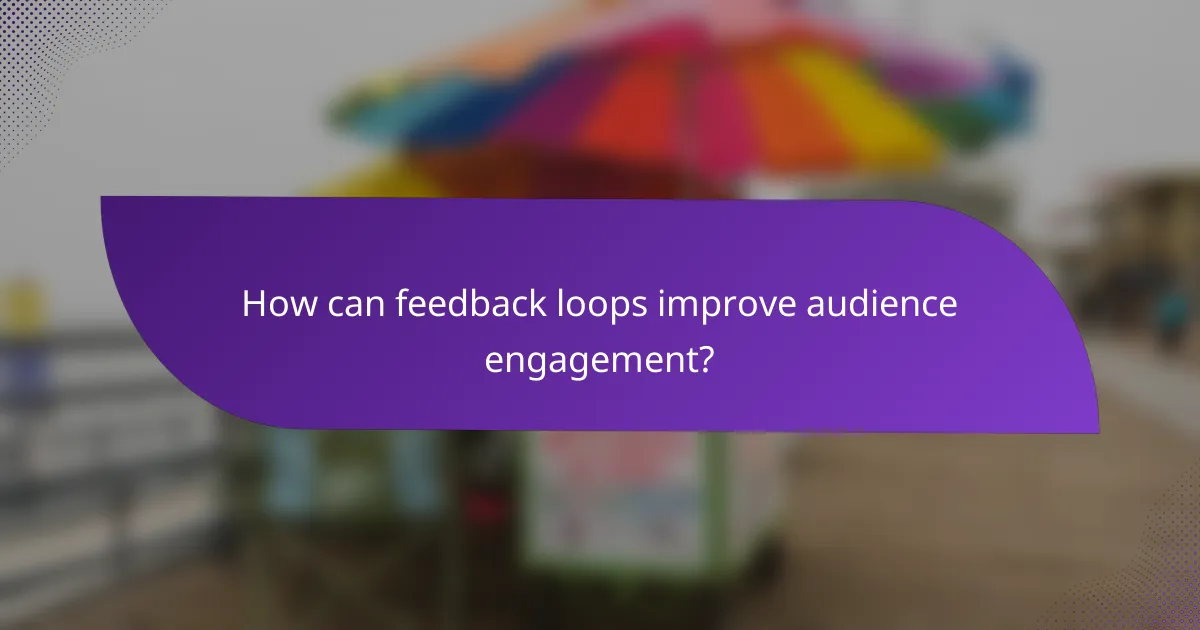Engaging an audience in digital advertising presents unique challenges, particularly in maintaining their interest and fostering interaction. By employing dynamic content, personalization, and compelling narratives, businesses can create memorable experiences that resonate with users. Additionally, incorporating interactive strategies and establishing feedback loops can enhance participation and adapt to audience preferences, ultimately cultivating a more connected and engaged community.

How can businesses maintain audience interest in digital advertising?
Businesses can maintain audience interest in digital advertising by employing various strategies that engage users and create a memorable experience. Key approaches include utilizing dynamic content, personalizing experiences, crafting compelling narratives, leveraging social proof, and incorporating gamification.
Utilizing dynamic content
Dynamic content refers to web elements that change based on user behavior, preferences, or demographics. This approach keeps advertisements relevant and engaging, as users see content tailored to their interests. For instance, an e-commerce site might display different product recommendations based on previous browsing history.
To effectively implement dynamic content, businesses should invest in data analytics tools that track user interactions. Regularly updating content based on user feedback can also enhance engagement and retention.
Implementing personalized experiences
Personalized experiences involve customizing interactions based on individual user data, such as location, purchase history, or browsing habits. This strategy can significantly increase engagement rates, as users feel more connected to brands that understand their needs. For example, sending targeted emails with product suggestions based on past purchases can drive conversions.
To achieve personalization, businesses should collect and analyze user data responsibly, ensuring compliance with privacy regulations. Offering users control over their data preferences can also foster trust and enhance the overall experience.
Creating compelling narratives
Compelling narratives captivate audiences by telling a story that resonates with their emotions and experiences. This storytelling approach can make advertisements more relatable and memorable. For instance, a brand might share customer success stories to highlight the impact of their products.
When crafting narratives, focus on authenticity and relatability. Use visuals and language that reflect the target audience’s values and interests, creating a deeper connection with the brand.
Leveraging social proof
Social proof involves using testimonials, reviews, and user-generated content to build credibility and trust. When potential customers see that others have had positive experiences, they are more likely to engage with a brand. For example, showcasing customer reviews prominently on a website can influence purchasing decisions.
To effectively leverage social proof, businesses should encourage satisfied customers to share their experiences online. Highlighting awards or certifications can also enhance credibility and attract new audiences.
Incorporating gamification
Gamification involves integrating game-like elements into advertising to boost engagement and motivation. This can include rewards, challenges, or interactive quizzes that encourage participation. For example, a brand might create a loyalty program where customers earn points for completing specific actions, such as sharing content on social media.
When incorporating gamification, ensure that the elements are relevant to the brand and provide real value to users. Avoid overly complex systems that may deter participation; simplicity and fun are key to successful gamification strategies.

What interactive strategies enhance audience engagement?
Interactive strategies that enhance audience engagement include techniques that actively involve participants, making them feel more connected to the content. These methods not only capture attention but also encourage feedback and participation, creating a dynamic experience.
Live polls and surveys
Live polls and surveys are effective tools for gauging audience opinions in real-time. They can be integrated into presentations or social media platforms, allowing participants to share their thoughts instantly. Consider using platforms like Slido or Mentimeter, which provide user-friendly interfaces for creating engaging polls.
To maximize participation, keep polls short and relevant. Aim for 2-5 questions that relate directly to the content being discussed. This approach not only maintains interest but also provides valuable insights into audience preferences.
Interactive infographics
Interactive infographics transform static data into engaging visual stories that audiences can explore. By allowing users to click, hover, or scroll through information, these infographics can make complex data more digestible. Tools like Canva or Piktochart can help create visually appealing and interactive designs.
When designing interactive infographics, focus on clarity and usability. Ensure that the most critical information is easily accessible, and consider incorporating animations or transitions to guide users through the content without overwhelming them.
Webinars and live Q&A sessions
Webinars and live Q&A sessions provide a platform for direct interaction between presenters and the audience. These formats allow participants to ask questions and engage with the content in real-time, fostering a sense of community. Popular platforms for hosting webinars include Zoom and Microsoft Teams.
To enhance engagement during these sessions, encourage questions throughout the presentation rather than waiting until the end. This approach keeps the audience involved and can lead to more dynamic discussions. Additionally, consider recording sessions for later access, allowing those who could not attend live to participate asynchronously.
Augmented reality experiences
Augmented reality (AR) experiences offer immersive ways to engage audiences by blending digital content with the real world. This technology can be used in marketing campaigns, educational tools, or product demonstrations, providing a unique way for users to interact with information. Apps like ARKit or ARCore can facilitate the development of AR experiences.
When implementing AR, ensure that the experience is user-friendly and adds value to the content. Avoid overly complex interactions that may frustrate users. Instead, focus on enhancing understanding and enjoyment through intuitive designs and clear instructions.

How can feedback loops improve audience engagement?
Feedback loops enhance audience engagement by creating a continuous cycle of input and response, allowing content creators to adapt to audience preferences effectively. This process not only keeps the audience interested but also fosters a sense of community and participation.
Regular audience feedback collection
Collecting feedback regularly is essential for understanding audience needs and preferences. Utilize surveys, polls, and social media interactions to gather insights on what resonates with your audience. Aim for a frequency that keeps the conversation ongoing, such as monthly or quarterly check-ins.
Consider incentivizing feedback participation with rewards like discounts or exclusive content. This approach can increase response rates and provide more valuable data for future content strategies.
Data-driven content adjustments
Using the feedback collected, make informed adjustments to your content. Analyze the data to identify trends and preferences, allowing you to tailor your offerings accordingly. For instance, if audience feedback indicates a preference for video content over articles, consider increasing your video production efforts.
Implement A/B testing to evaluate different content formats or topics. This method helps determine what engages your audience most effectively, enabling you to refine your strategy based on real-world performance.
Engagement metrics analysis
Regularly analyze engagement metrics to gauge the effectiveness of your content and feedback loops. Key metrics include click-through rates, time spent on page, and social media shares. These indicators provide insight into how well your audience is responding to your adjustments.
Set benchmarks for these metrics to track progress over time. For example, aim for a specific percentage increase in engagement within a defined period, which can help you assess the impact of your feedback-driven changes.

What are the prerequisites for effective audience engagement?
Effective audience engagement requires a deep understanding of your audience and clear objectives for interaction. By knowing who your audience is and what you aim to achieve, you can create meaningful connections that maintain interest and encourage participation.
Understanding audience demographics
Understanding audience demographics involves analyzing characteristics such as age, gender, location, and interests. This information helps tailor content and engagement strategies to resonate with specific groups. For instance, younger audiences may prefer interactive content like polls or quizzes, while older demographics might appreciate in-depth articles or webinars.
Consider using tools like surveys or analytics platforms to gather demographic data. This data can guide your content creation and ensure that you address the preferences and needs of your audience effectively.
Setting clear engagement goals
Setting clear engagement goals is essential for directing your efforts and measuring success. Goals can range from increasing audience participation in discussions to boosting content shares or enhancing feedback collection. Establishing specific, measurable objectives helps you stay focused and evaluate your strategies.
For example, a goal might be to increase social media interactions by 20% over three months. Regularly review your progress towards these goals and adjust your strategies as needed to ensure ongoing audience engagement.

What emerging trends are shaping audience engagement in advertising?
Emerging trends in audience engagement are increasingly driven by technology, social responsibility, and immersive experiences. Advertisers are focusing on personalization, sustainability, virtual reality, and community involvement to capture and maintain audience interest.
Artificial intelligence in personalization
Artificial intelligence (AI) is revolutionizing how brands personalize their advertising efforts. By analyzing user data, AI can tailor content to individual preferences, enhancing relevance and engagement. For example, AI algorithms can recommend products based on browsing history, leading to higher conversion rates.
To effectively implement AI personalization, brands should ensure they have robust data collection methods and respect user privacy. Avoid overwhelming users with excessive personalization, as it may lead to discomfort or distrust.
Increased focus on sustainability
Brands are increasingly prioritizing sustainability in their advertising strategies to resonate with environmentally conscious consumers. This trend involves promoting eco-friendly practices, products, and corporate social responsibility initiatives. Companies that transparently communicate their sustainability efforts often build stronger connections with their audience.
To leverage this trend, brands should highlight specific sustainable practices, such as using recyclable materials or reducing carbon footprints. Avoid vague claims; instead, provide concrete examples and measurable outcomes to enhance credibility.
Integration of virtual reality experiences
Virtual reality (VR) is becoming a powerful tool for engaging audiences through immersive experiences. By allowing users to interact with products or services in a virtual environment, brands can create memorable experiences that enhance emotional connections. For instance, a furniture retailer might offer a VR app that lets customers visualize how a piece of furniture would look in their home.
When integrating VR, brands should ensure the technology is accessible and user-friendly. Avoid overly complex experiences that may frustrate users; instead, focus on simplicity and ease of navigation to maximize engagement.
Shift towards community-driven content
Community-driven content is gaining traction as brands recognize the value of audience participation in shaping their messaging. This approach involves encouraging user-generated content, fostering discussions, and building online communities around shared interests. Engaging audiences in this way can lead to increased loyalty and advocacy.
To implement community-driven strategies, brands should create platforms for audience interaction, such as social media groups or forums. Avoid controlling the narrative too tightly; instead, allow authentic conversations to flourish, which can enhance trust and relatability.
